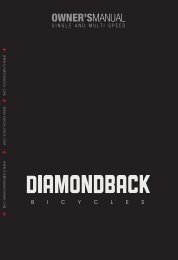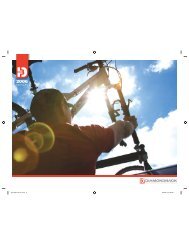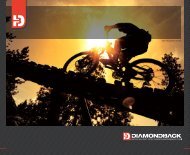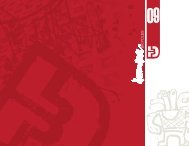Owner's Manual - Diamondback Bicycles
Owner's Manual - Diamondback Bicycles
Owner's Manual - Diamondback Bicycles
You also want an ePaper? Increase the reach of your titles
YUMPU automatically turns print PDFs into web optimized ePapers that Google loves.
harder, “faster” gear (like 2 or 3) is called an upshift.Shifting from a harder, “faster” gear to an easier, “slower”gear is called a downshift. It is not necessary to shiftgears in sequence. Instead, find the “starting gear” forthe conditions — a gear which is hard enough for quickacceleration but easy enough to let you start from a stopwithout wobbling — and experiment with upshifting anddownshifting to get a feel for the different gears. At first,practice shifting where there are no obstacles, hazards orother traffic, until you’ve built up your confidence. Learnto anticipate the need to shift, and shift to a lower gearbefore the hill gets too steep. If you have difficulties withshifting, the problem could be mechanical adjustment.See your dealer for help.E. Pedals1. Toe Overlap is when your toe can touch the frontwheel when you turn the handlebars to steer while apedal is in the forwardmost position. This is commonon small-framed bicycles, and is avoided by keepingthe inside pedal up and the outside pedal down whenmaking sharp turns. This technique will also prevent theinside pedal from striking the ground in a turn.! WARNING: Toe Overlap could cause you to losecontrol and fall. Ask your dealer to help you determine ifthe combination of frame size, crank arm length, pedaldesign and shoes you will use results in pedal overlap.If you have overlap, you must keep the inside pedal upand the outside pedal down when making sharp turns.2. Some bicycles come equipped with pedals that25have sharp and potentially dangerous surfaces. Thesesurfaces are designed to add safety by increasing gripbetween the rider’s shoe and the pedal. If your bicyclehas this type of high-performance pedal, you must takeextra care to avoid serious injury from the pedals’ sharpsurfaces. Based on your riding style or skill level, you mayprefer a less aggressive pedal design, or chose to ridewith shin pads. Your dealer can show you a number ofoptions and make suitable recommendations.3. Toeclips and straps are a means to keep feetcorrectly positioned and engaged with the pedals.The toeclip positions the ball of the foot over the pedalspindle, which gives maximum pedaling power. Thetoe strap, when tightened, keeps the foot engagedthroughout the rotation cycle of the pedal. While toeclipsand straps give some benefit with any kind of shoe, theywork most effectively with cycling shoes designed for usewith toeclips. Your dealer can explain how toeclips andstraps work. Shoes with deep treaded soles or welts whichmight allow the foot to be trapped should not be usedwith toeclips and straps.! WARNING: Getting into and out of pedals withtoeclips and straps requires skill which can only beacquired with practice. Until it becomes a reflex action,the technique requires concentration which can distractyour attention and cause you to lose control and fall.Practice the use of toeclips and straps where there are noobstacles, hazards or traffic. Keep the straps loose, anddon’t tighten them until your technique and confidencein getting in and out of the pedals warrants it. Never ridein traffic with your toe straps tight.










